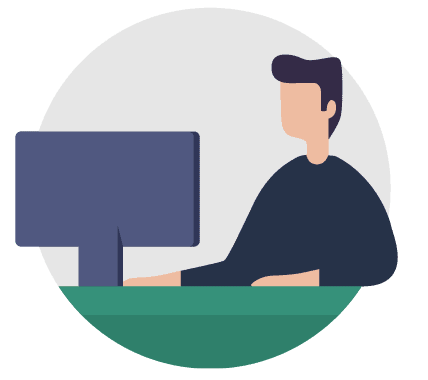Google RankBrain:The Definitive Guide
Google RankBrain is definitely still relevant in 2024.
In fact, it’s arguably more important than ever for anyone concerned with SEO and online visibility.
In today’s guide, you’re going to learn everything you need to know about Google’s RankBrain algorithm.
Let’s do this.

Chapter 1:Google RankBrain: A Visual
Explanation

What is Google RankBrain?
Google RankBrain is an machine learning (AI) algorithm that helps understand search queries and deliver relevant results. It analyzes how users interact with search results and learns from them to improve future searches. In short, it helps Google know what you really want from your searches.
So: what makes RankBrain different?
Before RankBrain, 100% of Google’s algorithm was hand-coded. So the process went something like this:

Human engineers still work on the algorithm, of course. But today, RankBrain also does its thing in the background.

In short, RankBrain tweaks the algorithm on its own.
Depending on the keyword, RankBrain will increase or decrease the importance of backlinks, content freshness, content length, domain authority etc.
Then, it looks at how Google searchers interact with the new search results. If users like the new algorithm better, it stays. If not, RankBrain rolls back the old algorithm.
Here’s the craziest part:
Google asked a group of Google Engineers to identify the best page for a given search. They also asked RankBrain.
And RankBrain outperformed brainy Google engineers by 10%!

In short, RankBrain works. And it’s here to stay.
Now that you’ve seen an overview of what RankBrain is, let’s dive deeper into how it works.
Chapter 2:How RankBrain Works

RankBrain has two main jobs:
1. Understanding search queries (keywords)
2. Measuring how people interact with the results (user satisfaction)
Let’s break each of these down.
How RankBrain Understands Any Keyword That You Search For
A few years ago, Google had a problem:
15% of the keywords that people typed into Google were never seen before.
15% may not seem like a lot. But when you process billions of searches per day, that amounted to 450 million keywords that stumped Google every day.
Before RankBrain, Google would scan pages to see if they contained the exact keyword someone searched for.
But because these keywords were brand new, Google had no clue what the searcher actually wanted. So they guessed.
For example, let’s say you searched for “the grey console developed by Sony”. Google would look for pages that contained the terms “grey”, “console”, “developed” and “Sony”.

Today, RankBrain actually understands what you’re asking. And it provides a 100% accurate set of results:

Not bad.
What changed? Before, Google would try to match the words in your search query to words on a page.
Today, RankBrain tries to actually figure out what you mean. You know, like a human would.
How? By matching never-before-seen keywords to keywords that Google HAS seen before.
For example, Google RankBrain may have noticed that lots of people search for “grey console developed by Nintendo”.
And they’ve learned that people who search for “grey console developed by Nintendo” want to see a set of results about gaming consoles.
So when someone searches for “the grey console developed by Sony”, RankBrain brings up similar results to the keyword it already knows (“grey console developed by Nintendo”).
So it shows results about consoles. In this case, the PlayStation.

Another example: a while back Google published a blog post about how they’re using machine learning to better understand searcher intent:

In that post they describe a technology called “Word2vec” that turns keywords into concepts.
For example, Google says that this technology “understands that Paris and France are related the same way Berlin and Germany are (capital and country), and not the same way Madrid and Italy are”.

Even though this post wasn’t talking specifically about RankBrain, RankBrain likely uses similar technology.
In short: Google RankBrain goes beyond simple keyword-matching. It turns your search term into concepts… and tries to find pages that cover that concept.
In chapter 3 I’ll show you how this changes the way we should do SEO keyword research. But first, let’s cover the most interesting element of what RankBrain does…
How RankBrain Measures User Satisfaction
Sure, RankBrain can take a stab at understanding new keywords. And it can even tweak the algorithm on its own.
But the big question is:
Once RankBrain shows a set of results, how does it know if they’re actually good?
Well, it observes:
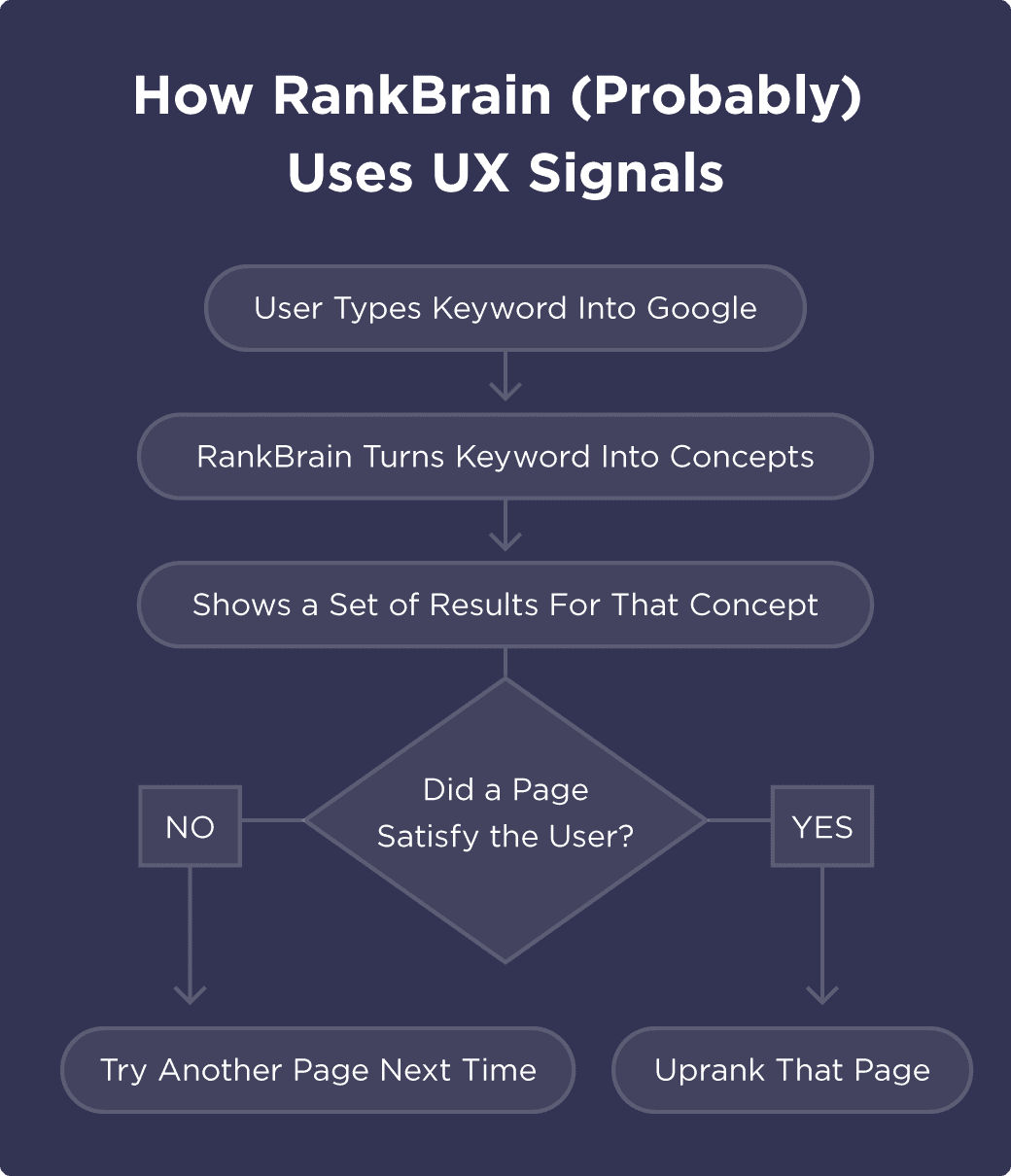
In other words, RankBrain shows you a set of search results that they think you’ll like. If lots of people like one particular page in the results, they’ll give that page a rankings boost.
And if you hated it? They’ll drop that page and replace it with a different page. And the next time someone searches for that keyword (or a similar term), they’ll see how it performs.
What is RankBrain observing exactly?
It’s paying very close attention to how you interact with the search results. Specifically, it’s looking at:
- Organic Click-Through-Rate
- Dwell Time
- Bounce Rate
- Pogo-sticking
These are known as user experience signals (UX signals).
Let’s look at an example:
You pulled a muscle in your back playing tennis. So you search for “pulled back muscle” in Google.

Like most people, you click on the first result. Unfortunately, the intro is full of fluff and filler content (“Your back is an important muscle group…”).
So you hit your back button and check out the 2nd result:
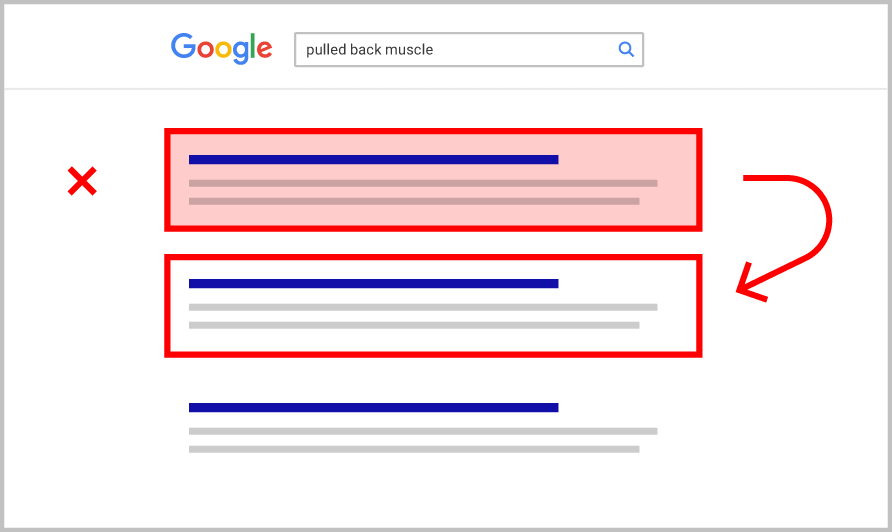
This one isn’t much better. It’s full of generic advice like “rest and ice your back”.
So you hit your browser’s back button yet again and give result #3 a shot.
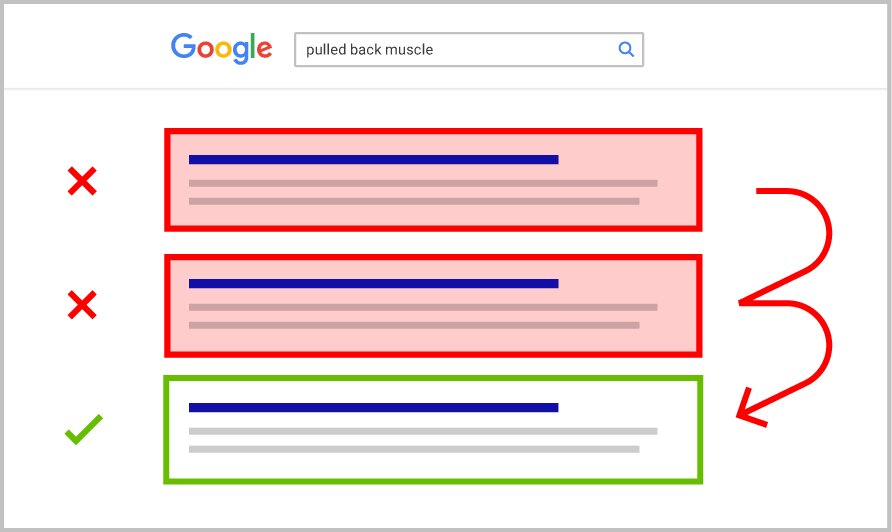
Bingo! This result is EXACTLY what you’re looking for.
So instead of hitting “back”, you spend 5 minutes reading through the page’s physical therapy routine. And because you got what you wanted, you didn’t revisit the search results.
This back-and-forth is called “Pogo-sticking”. And it’s something that RankBrain pays a lot of attention to.
If Google notices that people quickly leave a page to click on a different search result, that sends a strong message to Google: “That page stinks!”.

And if Google notices that lots of people STOP pogo-sticking on a specific result, they’re going to give that page a boost to make it easier to find.
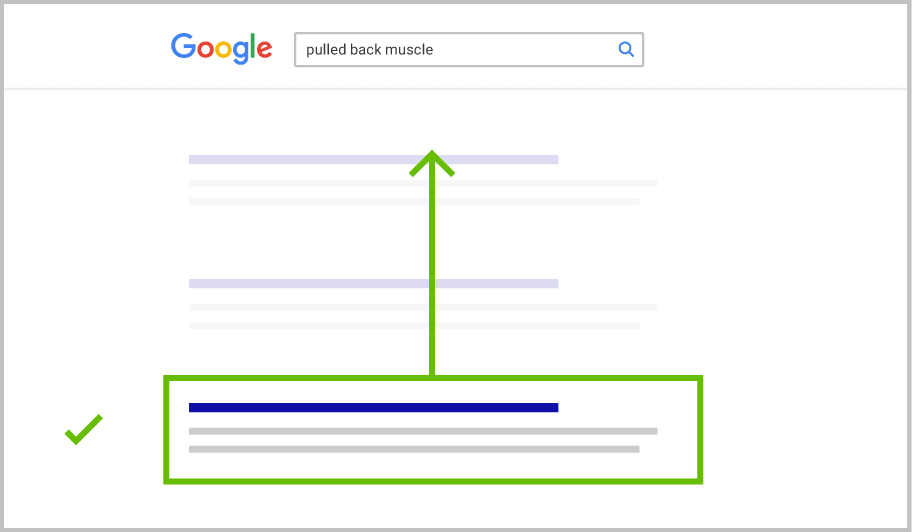
I’ll have lots more on optimizing for UX signals in Chapters 4 and 5. But for now, it’s time for me to show you how RankBrain changes how keyword research works.
Chapter 3:Keyword Research in a
RankBrain World

As you saw, Google can now understand the INTENT behind a keyword.
So does that mean that traditional keyword research is dead?
Nope!
That said, you may need to tweak your keyword research process so it’s more RankBrain-friendly.
Here’s how:
Ignore Long Tail Keywords (They’re Obsolete)
Long tail keywords are dead.
(There, I said it)
Back in the day it made sense to create hundreds of different pages… each one optimized around a different keyword.
For example, you’d create one page optimized for “best keyword research tool”. And another optimized for “best tool for keyword research”.
And old Google would rank each of them for their respective long tail keywords.

Today, RankBrain understands that these terms are basically the same thing. So they show nearly identical search results.

In short, optimizing for long tail keywords doesn’t make sense anymore.
What should you do instead? Keep reading…
Optimize Around Medium Tail Keywords
Instead of long tails, I recommend optimizing content around Medium Tail Keywords.
Medium Tail Keywords are middle-of-the-pack terms. They get more search volume than your average long tail. But they’re not insanely competitive, either.
For example, here’s a set of keywords around the topic of “Paleo Diet”. The terms in the middle are Medium Tail Keywords.

When you optimize your page around a medium tail keyword (and make that page awesome), RankBrain will automatically rank you for that term… and thousands of similar keywords.

In short, I recommend optimizing your page around a single keyword.
(Just make sure it’s a Medium Tail Keyword)
Then, let RankBrain rank your single page for lots of different related keywords.
How about an example of this process in action?
Example of Keyword Research and On-Page SEO in a RankBrain World
A while back I decided to write reviews for all of the SEO tools that I ever used.
The result? SEO Tools: The Complete List.

Because my content provides a ridiculous amount of value on a single page, it ranks in the top 5 for my target (Medium Tail) keyword: SEO Tools.

But more important than that, RankBrain understands that my page is about concepts like: “SEO Tools”, “SEO software”, “keyword research tools” etc.
That’s why this single page ranks for 1,800 different keywords (according to SEMrush):
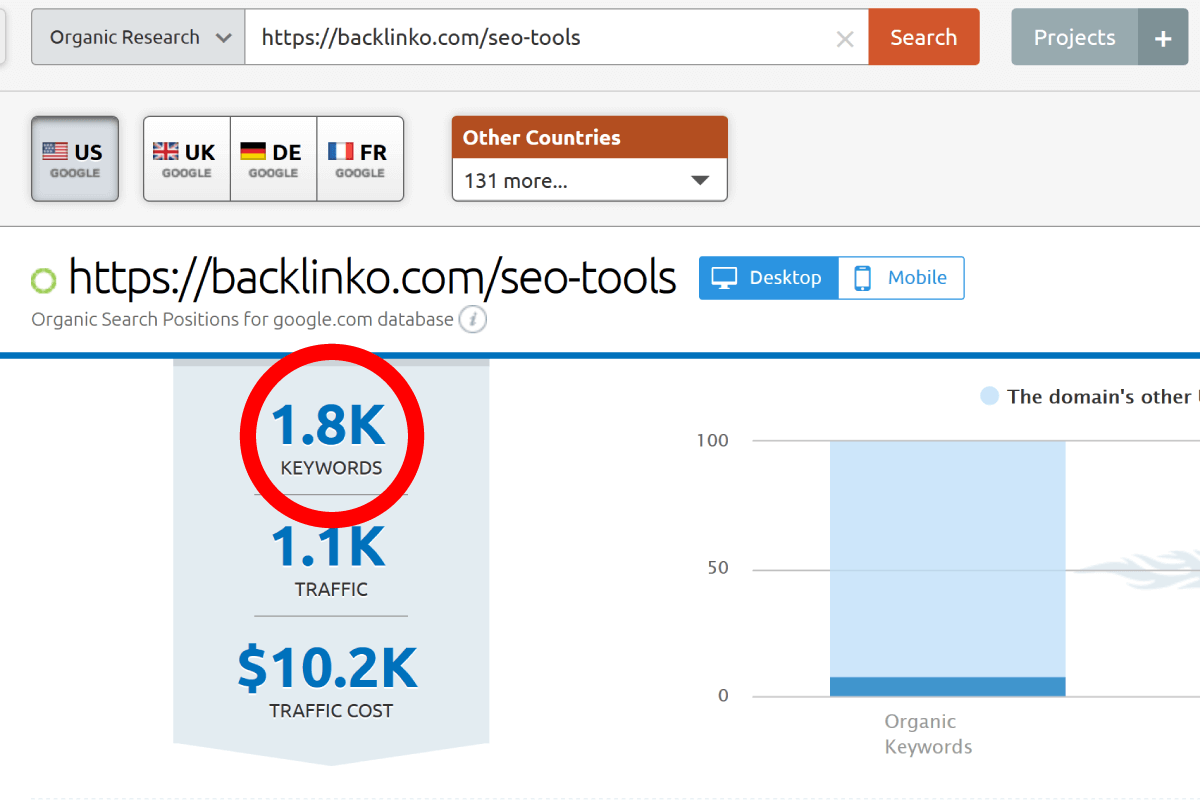
That’s the power of optimizing amazing content around a single, Medium Tail Keyword.
Chapter 4:How to Optimize Titles and
Description Tags for CTR
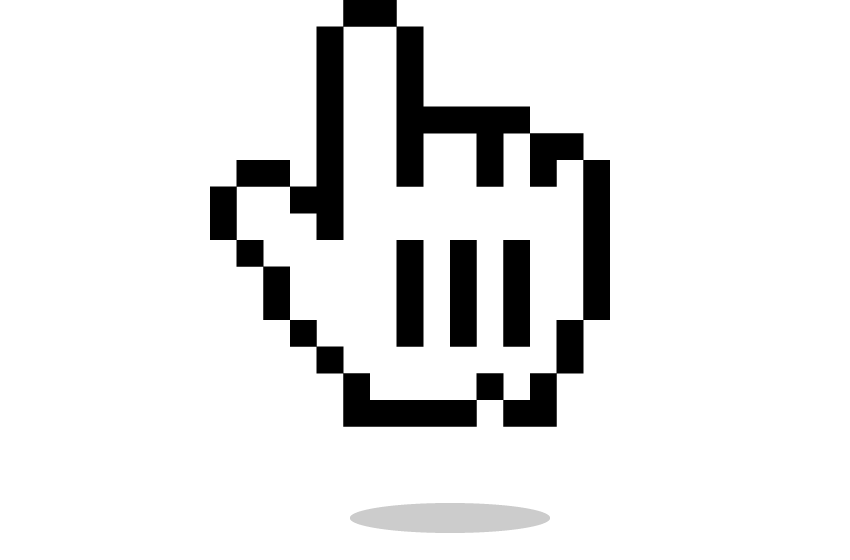
As you saw in chapter 1, organic CTR is a key RankBrain ranking signal.
The question is: how can you get people to click on your result?
Well, that’s exactly what I’m going to cover in this chapter.
Pack Your Title Tags With Emotion
There’s no doubt about it: emotional titles get more clicks.
This is something copywriters have known for years. And in recent years this idea has been backed up with data. In fact, CoSchedule found a clear correlation between highly emotional headlines and social shares.
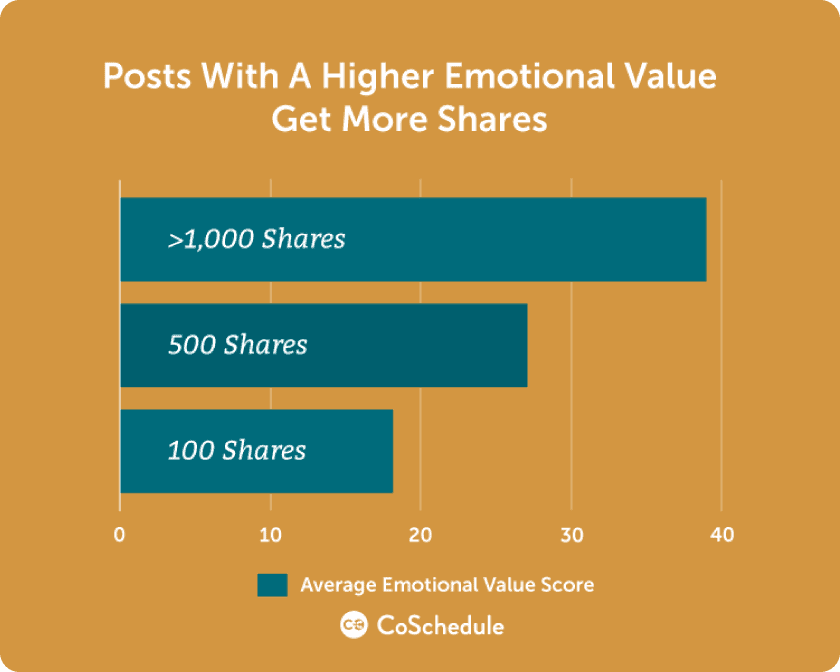
For example, here’s a generic SEO-optimized title tag:
Productivity Tips: How to Get More Done
Not bad. But it lacks the “umph” that pushes people to click.
Here’s how you could turn that title tag into an emotional powerhouse (while keeping it SEO-friendly):
Crush Your To-Do List With These 17 Productivity Tips
Now it doesn’t always make sense to create highly-emotional titles. But whenever you can, you should.
Add Brackets and Parentheses to the End Of Your Titles
This is my all-time favorite CTR hack.
I first discovered this tip from a study that HubSpot and Outbrain did a few years back…
In that study they analyzed 3.3 million headlines. And they found that brackets outperformed bracketless titles by 33%:

In fact, this little tactic works so well that I tend to include parentheses in most of my titles:

Here are some examples of brackets and parentheses you can use:
[Infographic]
[Report]
(Proven Tips)
You get the idea 🙂
Use Numbers (And Not Just on List Posts)
The data from several sources (including BuzzSumo) is clear: numbers improve CTR.
The best part?
You can use numbers in your title… even if your content isn’t a list post.
For example, last year I published this case study:

As you can see, I included not one, but TWO numbers in the title.
Don’t Forget to Optimize Your Description Tag for CTR
Yes, description tags don’t directly help with SEO anymore. That said, I’ve found that an optimized description can significantly boost your CTR.
Here’s how to create a description tag that gets results:
First, make it emotional.
Just like with a title tag, you want your description tag to convey some emotion.
Here’s an example:

Next, sell WHY someone should click on your result.
Is your content comprehensive? Based on research? Funny? Sell that in your description:

Then, copy words and phrases that paid ads (AdWords) use.
For example, when I search for “bone broth” I see this phrase appear in two ads:
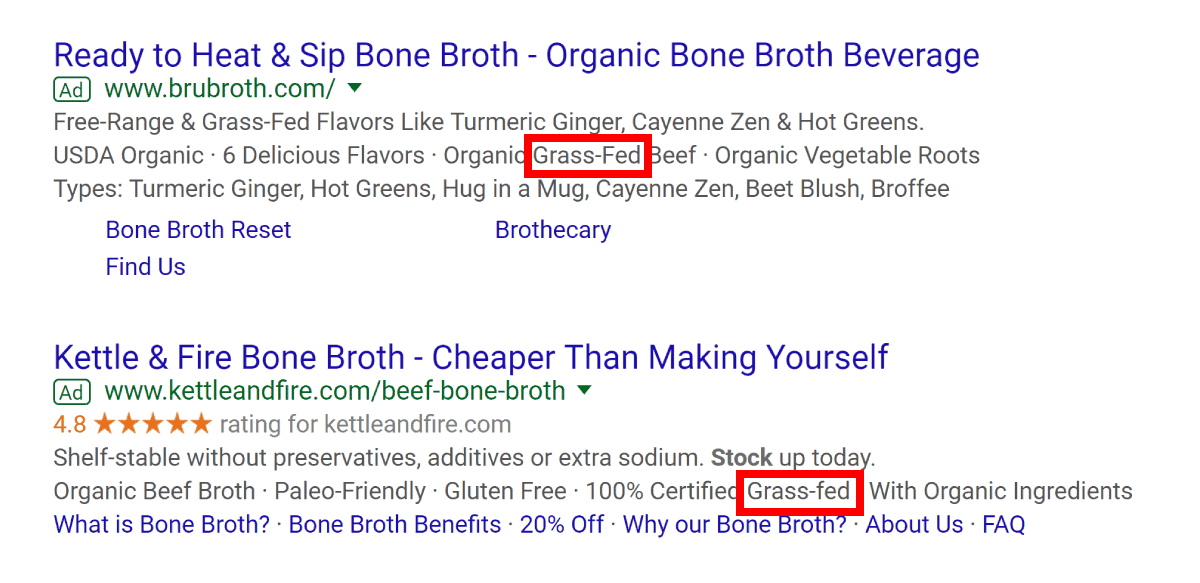
So you’d want to include the phrase “grass fed” in your meta description.
Finally, include your target keyword.
Google will make it bold, which can help your result stand out:

That’s all there is to it.
Chapter 5:How to Optimize Your Content
for Bounce Rate and Dwell Time

OK so you used my CTR-boosting tips. And more people are clicking on your result than ever before.
Now what? Well, you need to show Google that your result makes their users happy.
And the best way to do that? Improve your dwell time.
Does Google REALLY Use Dwell Time? Yup!
Dwell time is the amount of time a Google searcher spends on your site after clicking on your result.
Obviously, the longer someone spends on your page, the better. This tells Google: “Man, people are LOVING this result. Let’s bump it up a few spots”.
And if someone bounces from your site after 2 seconds, that tells Google: “This result stinks! Let’s drop it down a few spots”.
So it’s logical that RankBrain would measure Dwell Time — and shuffle the results around based on this signal.
In fact, a Google employee recently said that Google used to rely 100% on off-page signals (especially backlinks). Even though Google still uses backlinks, this employee pointed out that:

And the data backs this up. When we analyzed a massive set of Google search results we found a correlation between high rankings and low bounce rate:
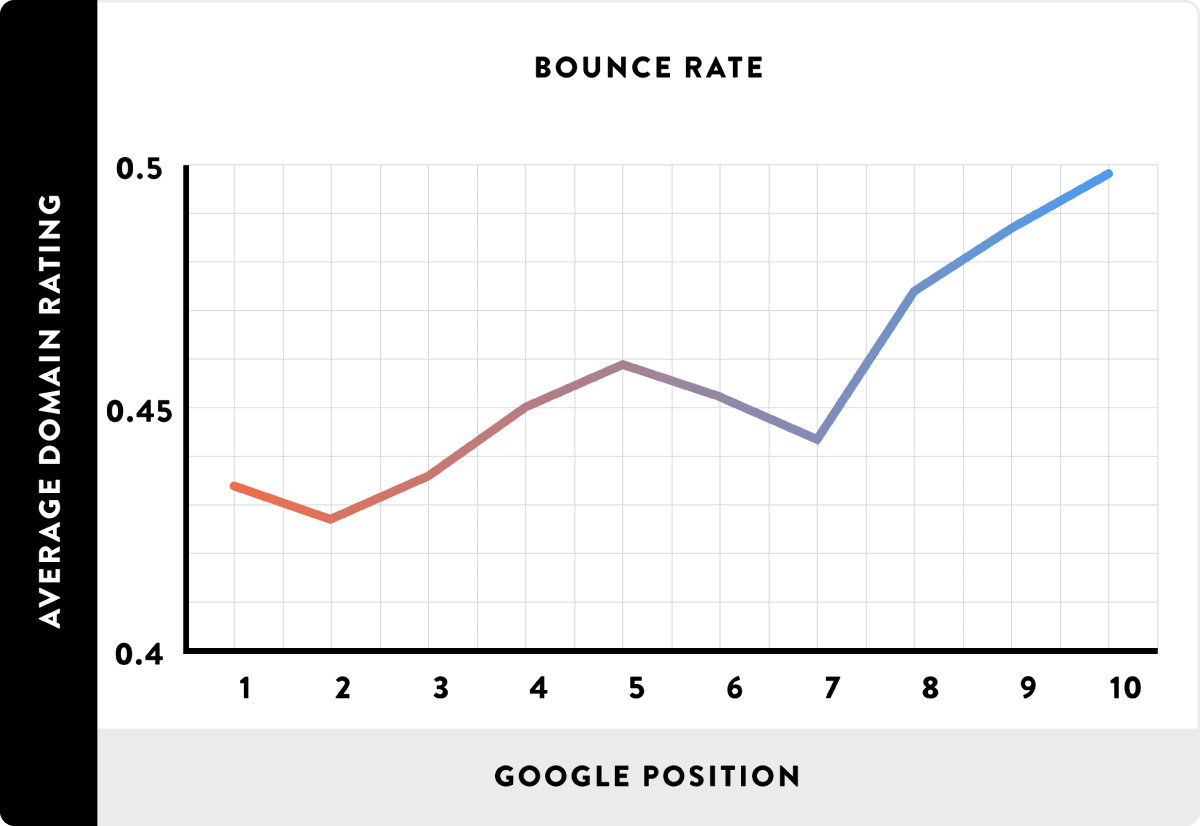
How to Reduce Bounce Rate and Boost Dwell Time
Now it’s time for me to share a few simple strategies that you can use to increase your site’s dwell time.
Push Your Content Above the Fold
When someone clicks on your site from Google, they want their question answered NOW.
In other words, they don’t want to scroll down to read your content.
That’s why I highly recommend removing anything that pushes your content below the fold, like this:
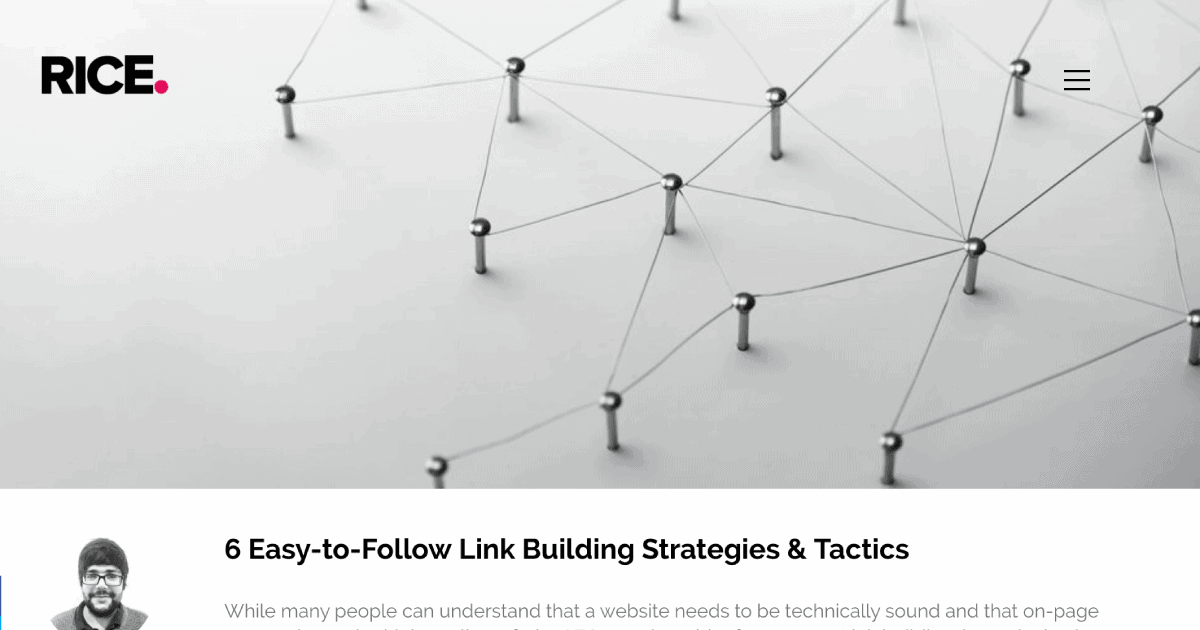
Instead, you want the first sentence of your content front-and-center:

That way, you’ll hook your reader right off the bat.
Use Short Intros (5-10 Sentences MAX)
Believe it or not, but I spend MORE time on my intros than my headlines.
That’s because your intro is where 90% of your readers decide to stay… or go.
And after A LOT of testing I’ve found that short intros work best.
Why?
When someone searches for something in Google, they already know about that topic. So there’s no need for a massive intro.
Instead, use your intro to sell the content they’re about to read, like this:

When someone searches for “white hat SEO” reads that intro they think: “Awesome! I’m in the right place.”
Publish Long, In-Depth Content
I’ve tested this ten ways to Tuesday. And I can tell you with confidence that:
Longer content=better Dwell Time.
Obviously, it takes longer to read a 2000-word guide than a 400-word blog post. But that’s only part of the equation.
The other reason that long form content improves Dwell Time is the fact that longer content can fully answer a searcher’s query.
For example, let’s say that you search for “how to run a marathon”.

And the first result that you click on is a 300-word post. It kinda sorta answers your question… but leaves you wanting more.
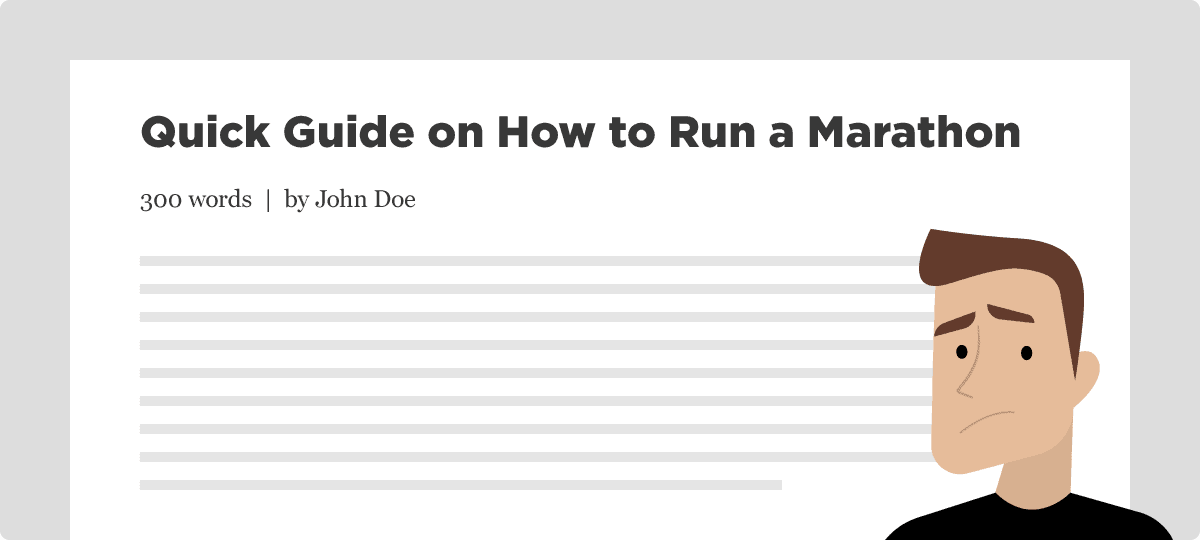
So you click on your back button to find something better (as you might remember, Google calls this “Pogo-sticking”).
And this time you hit the jackpot.
You find a comprehensive guide that covers EVERYTHING you need to know about running a marathon.

So you grab a cup of coffee and read the guide from start to finish. You even re-read certain sections. All this reading is racking up serious Dwell Time.
Long form content works so well that I tend to ONLY publish content that’s at least 2,000 words.
Break Up Your Content Into Bite Size Chunks
Let’s face it:
Reading 2,000 words is HARD.
And it’s even harder if those 2,000 words are presented as a giant wall of text.
Fortunately, there’s a simple way to get around this problem: subheaders.
Subheaders break up your content into digestible, bite-size chunks. This improves readability, and therefore, Dwell Time.
I use LOTS of subheaders at Backlinko for this exact reason:

Specifically, I try to toss in a subheader for every 200 words of content.
Pro Tip: Avoid boring subheaders like “Backhand Drills” or “Stay Hydrated”. Instead, pack your subheaders with emotion. For example: “3 Simple Backhand Drills The Pros Use” and “What New Research Says About Staying Hydrated.”
Chapter 6:Bonus RankBrain Optimization
Strategies and Case Studies

In this chapter I’m going to cover a handful of quick strategies that you can use to optimize your site for RankBrain.
Increase Brand Awareness. Improve CTR
I already showed you how numbers, emotions and Power Words can improve your organic CTR.
But there’s another HUGE variable that I haven’t mentioned: brand awareness.
Needless to say, if someone knows your brand, they’re more likely to click on your site in the search results. In fact, data from WordStream found that brand awareness can increase CTR by up to 342%!

For example, take a look at these search results:

Which two sites are you most likely to click on? NYTimes.com and Simply Recipes of course!
In other words, you want people to know about your brand BEFORE they search in Google.
How can you increase your brand’s awareness?
First, try Facebook ads.
Even if people don’t click and convert, Facebook ads can put your brand in front of lots of eyeballs.

And when those eyeballs are scanning the search results, they’re MUCH more likely to click on your result.
Also, create an insanely valuable email newsletter.
Nothing increases brand awareness more than sending valuable content to people’s inboxes.
In fact, my open rates are well above industry average because I only send good stuff:

Needless to say, my subscribers have learned that my material is the best in the business. So when Backlinko shows up on page 1, they’re much more likely to click on my result.
Finally, do a “Content Blitz”.
A “Content Blitz” is where you release a ton of content in a short period of time. And trust me: this is WAY more powerful than dripping content over the course of the year.
In fact, I used a Content Blitz when I first started Backlinko.
I published guest posts:
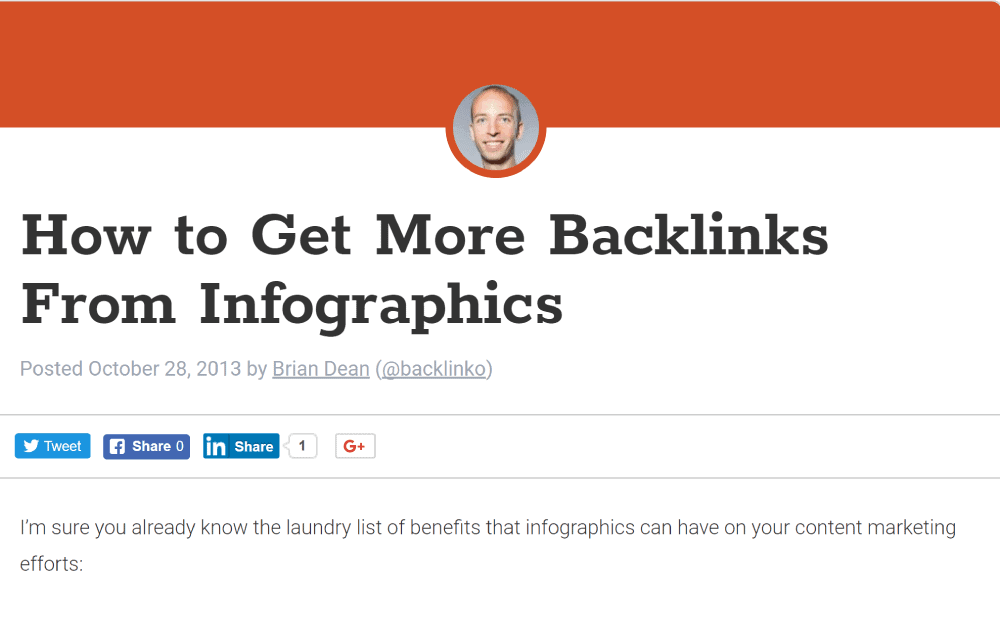
I went on Podcasts:
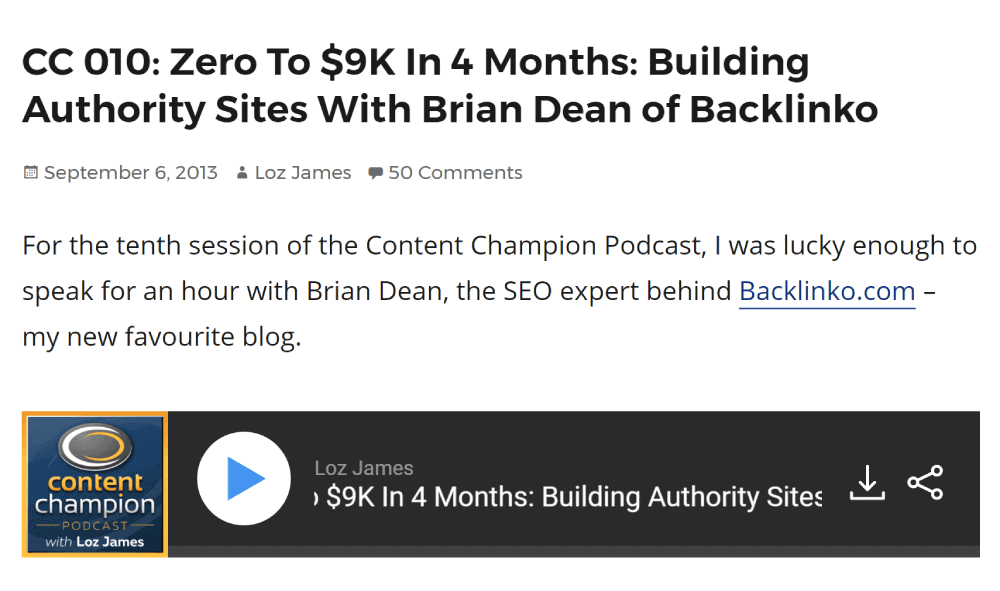
I even co-authored a guide with Neil Patel:

(All within a span of a few months)
And this helped take Backlinko from “What’s that?” to “What an awesome site!” in record time.
Turn “Zeros” to “Heros”
Do you have a page on your site that didn’t do as well as you’d hoped?
I have great news: if you go back and optimize that page for RankBrain, you can give it a SERIOUS rankings boost.
For example, Sean from Proven.com had a huge guide on his site that was doing OK… but wasn’t ranking as well as he had hoped.
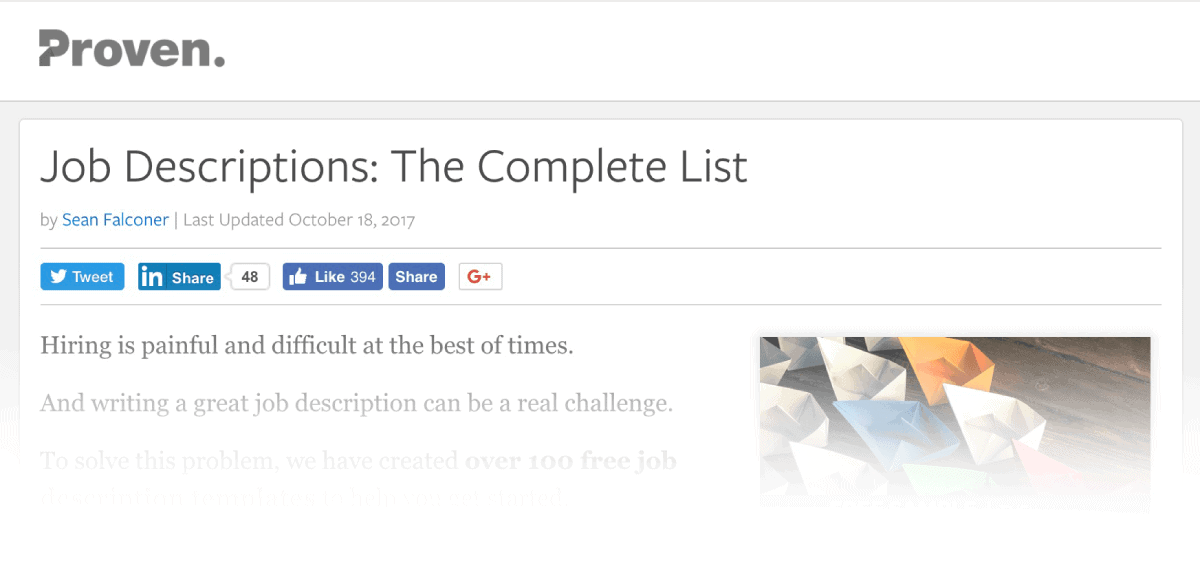
And Sean realized his page’s title tag wasn’t compelling to click on:

So he added a number, a Power Word and parentheses to his title tag:

And this single change increased Sean’s organic traffic to that page by nearly 128%:
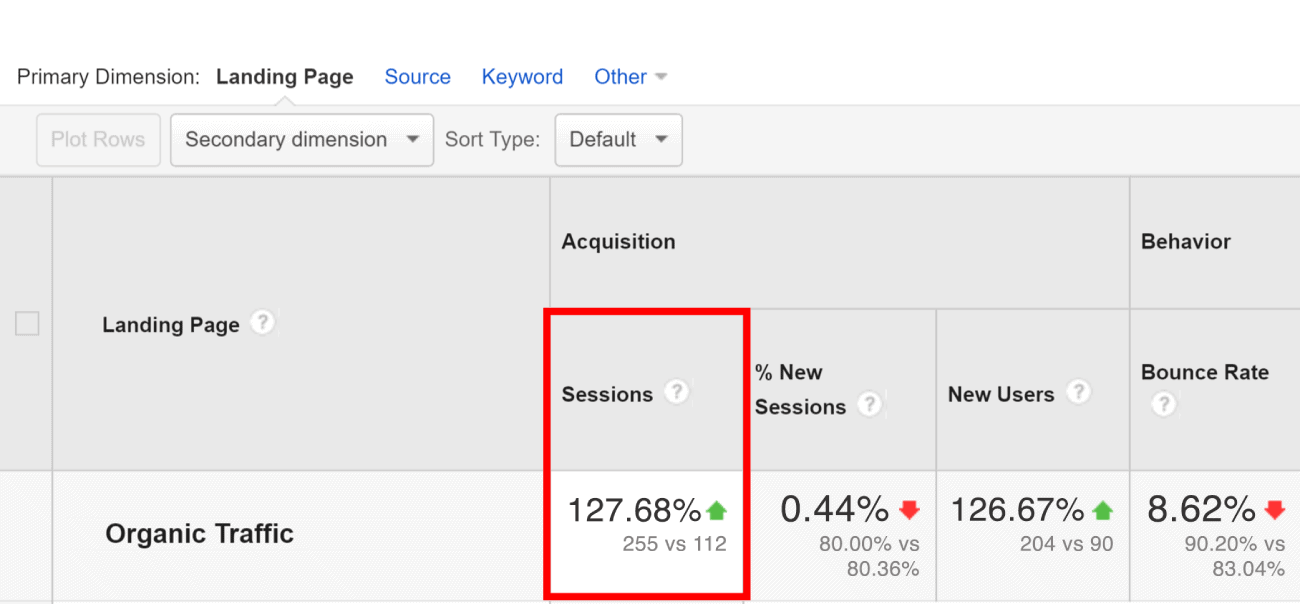
Yes, some of that traffic boost was due to the simple fact that more people were clicking on Sean’s result.
But the BIG part of the story was that RankBrain noticed the CTR increase… and nudged Sean’s page up a few spots:
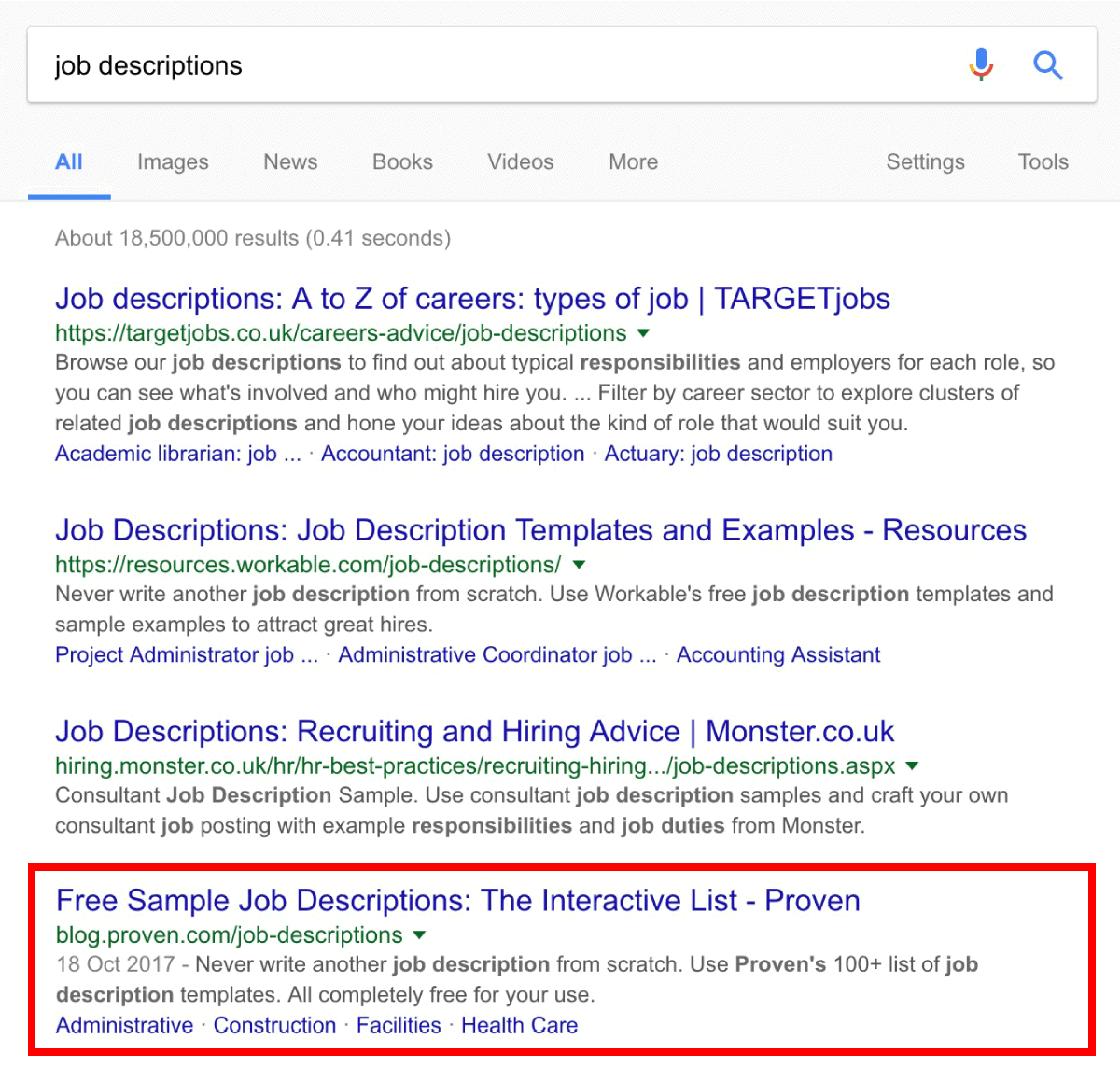
Use LSI Keywords to Fill in “Content Gaps”
LSI Keywords are words and phrases related to your content’s main topic.
Why are LSI Keywords important? Well, they give RankBrain the context they need to fully understand your page.
For example, let’s say that you’re writing a guide about link building.
LSI Keywords are things like:
- Backlinks
- Domain Authority
- Email outreach
- Anchor text
And when RankBrain sees that your content includes these terms, they’re confident that your page is about link building…
…which means you’re more likely to rank for keywords related to that topic.
You can uncover LSI keywords with the Watson Natural Language Understanding Tool.
This tool analyzes content that you give it for concepts, entities and categories.
For example, when I pasted in the first draft of this guide, it spit out concepts that were related to RankBrain.

The interesting part is that I didn’t mention many of these terms in the guide. Like RankBrain, Watson understands what my content is about. Very cool.
And when you sprinkle these LSI keywords into your post, you’ll confirm to RankBrain that your content is comprehensive.




